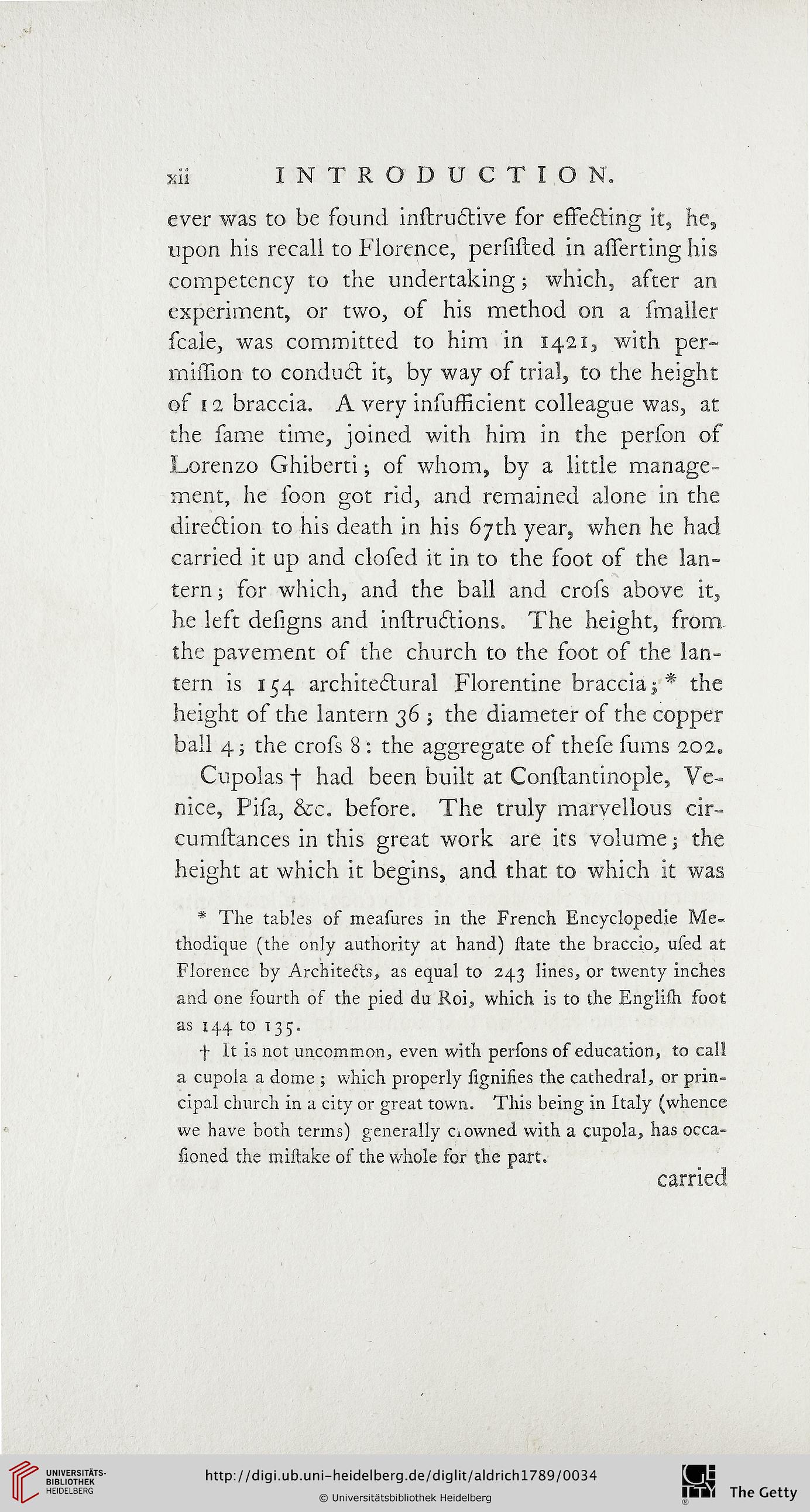INTRODUCTION.
jili
ever was to be found instrudtive for effe&ing it, he,
upon his recall to Florence, persisted in asserting his
competency to the undertaking; which, after an
experiment, or two, of his method on a smaller
scale, was committed to him in 1421, with per-
million to conduct it, by way of trial, to the height
os 12 braccia. A very inefficient colleague was, at
the same time, joined with him in the person of
Lorenzo Ghiberti; of whom, by a little manage-
ment, he soon got rid, and remained alone in the
direction to his death in his 67th year, when he had
carried it up and closed it in to the foot of the lan-
tern ; for which, and the ball and cross above it,
he left designs and instrudions. The height, from
the pavement of the church to the soot of the lan-
tern is 154 architectural Florentine braccia;* the
height of the lantern 36 ; the diameter of the copper
ball 4; the cross 8 : the aggregate of these sums 202.
Cupolas j- had been built at Constantinople, Ve-
nice, Pisa, &c. before. The truly marvellous cir-
cumstances in this great work are its volume; the
height at which it begins, and that to which it was
* The tables os measures in the French Encyclopedic Me-
thodique (the only authority at hand) state the braccio, used at
Florence by Architects, as equal to 243 lines, or twenty inches
and one sourth of the pied du Roi, which is to the Englilh foot
as 144 to 135.
4 It is not uncommon, even with persons of education, to call
a cupola a dome ; which properly signifies the cathedral, or prin-
cipal church in a city or great town. This being in Italy (whence
we have both terms) generally Ci owned with a cupola, has occa-
sioned the mistake of the whole for the part.
carried
jili
ever was to be found instrudtive for effe&ing it, he,
upon his recall to Florence, persisted in asserting his
competency to the undertaking; which, after an
experiment, or two, of his method on a smaller
scale, was committed to him in 1421, with per-
million to conduct it, by way of trial, to the height
os 12 braccia. A very inefficient colleague was, at
the same time, joined with him in the person of
Lorenzo Ghiberti; of whom, by a little manage-
ment, he soon got rid, and remained alone in the
direction to his death in his 67th year, when he had
carried it up and closed it in to the foot of the lan-
tern ; for which, and the ball and cross above it,
he left designs and instrudions. The height, from
the pavement of the church to the soot of the lan-
tern is 154 architectural Florentine braccia;* the
height of the lantern 36 ; the diameter of the copper
ball 4; the cross 8 : the aggregate of these sums 202.
Cupolas j- had been built at Constantinople, Ve-
nice, Pisa, &c. before. The truly marvellous cir-
cumstances in this great work are its volume; the
height at which it begins, and that to which it was
* The tables os measures in the French Encyclopedic Me-
thodique (the only authority at hand) state the braccio, used at
Florence by Architects, as equal to 243 lines, or twenty inches
and one sourth of the pied du Roi, which is to the Englilh foot
as 144 to 135.
4 It is not uncommon, even with persons of education, to call
a cupola a dome ; which properly signifies the cathedral, or prin-
cipal church in a city or great town. This being in Italy (whence
we have both terms) generally Ci owned with a cupola, has occa-
sioned the mistake of the whole for the part.
carried





